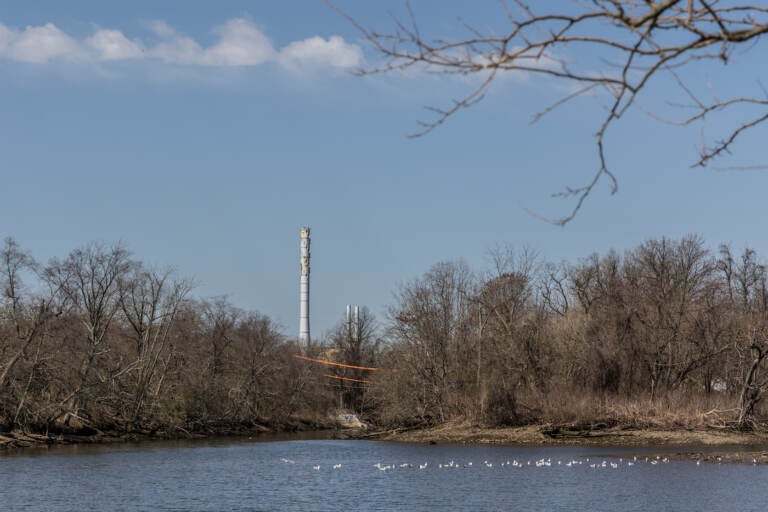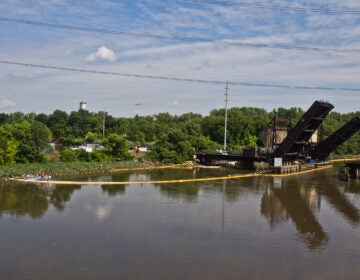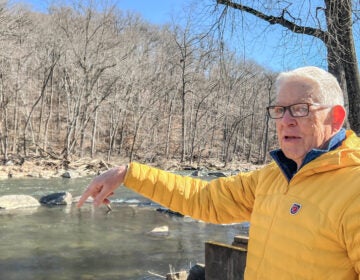During a chemical spill, Philly was unable to switch water sources. Here’s why that matters
The contamination threat is the latest in a series of disasters that underscore the need for infrastructure investments.

The point where the Otter Creek meets the Delaware River, south of the Bristol Marsh Preserve, at Delaware Canal State Park in Bristol, Pa. (Kimberly Paynter/WHYY)
Amid the chaos that unfolded in Philadelphia this past week — with thousands of gallons of chemicals spilled into a tributary of the Delaware River, supermarket shelves cleared of bottled water, and round-the-clock water sampling — Philadelphia Water Department officials knew one thing: They’d be unable to switch to a clean water source to serve much of the city if a key water treatment plant became contaminated.
Friday’s chemical spill in Bristol, Pennsylvania, is the latest in a series of disasters — including the water crisis in Flint, Michigan, and the train derailment in East Palestine, Ohio — that underscore the need for infrastructure investments, said Kelly Good, a professor of civil and environmental engineering at Villanova University.
“It’s bringing to the forefront of our minds that there are vulnerabilities,” Good said. “Drinking water and other infrastructure in the U.S. … needs a lot of investment.”
Late Friday, an estimated 8,000 gallons of a water-based latex finishing solution leaked from the Trinseo Altuglas chemical facility in Bucks County into the Delaware River. Just 13 miles downstream lies an intake pipe that draws water for Philadelphia’s largest drinking water treatment plant.
Philadelphia city officials said they closed the intake valves at the Baxter Water Treatment facility after learning of the spill, but were forced to open them again early Sunday to maintain minimum water levels, avoid equipment damage, and supply water for firefighting.
Hours later, the city recommended residents drink bottled water, which caused supply shortages at supermarkets. Residents received periodic alerts over the next few days, extending the timeframe in which officials were confident tap water would remain safe to drink.
Officials said Monday they had a plan if contamination occurred, but did not release it publicly.
Tuesday evening, city officials gave the all-clear; hydraulic modeling indicated that by the time the city would need to reopen the Baxter intake, the threat would have passed.
Philadelphia was not the only water treatment facility at risk. The Aqua plant in Bristol, New Jersey American’s plant in Delran, and Burlington, New Jersey’s water treatment plant all had intakes near the spill that could have drawn in contaminated water, according to the EPA.
Why Philly could not pivot to a different water source
Philadelphia’s placement between two rivers gives it options for where it sources drinking water, said Gerald Kauffman, who heads the University of Delaware’s Water Resources Center. The city has one intake on the Delaware River, which feeds the Baxter Water Treatment Plant in Northeast Philly, and two on the Schuylkill River, which feed the Belmont Treatment Plant in Wynnefield, and the Queen Lane Treatment Plant in East Falls. Only the Baxter plant along the Delaware River in Frankford would have been affected by Friday’s spill.
“The city was, I think, very smart in terms of engineering,” Kauffman said. “They have flexibility.”
But Philadelphia cannot fully utilize this flexibility. City officials said during a briefing Monday that the city lacks the ability to serve all customers with water drawn from the Schuylkill River.
“As of today, the 100% level of redundancy where we can switch from one treatment facility to the next is not something in our system, which is why we have to take the types of precautions at times like these,” said Mike Carroll, deputy managing director of the City’s Office of Transportation, Infrastructure, and Sustainability.
Achieving full redundancy within a drinking water system is difficult, said Charles Haas, a professor of environmental engineering at Drexel University.
Baxter is by far the city’s largest treatment plant, Haas said, so replicating that capacity using only the plants that draw from the Schuylkill would require either expanding them or building a new plant. He estimated this could cost “easily, multiple hundreds of millions of dollars.”
Another option for water utilities during emergencies is to take water in from nearby drinking water systems.
“In order to strengthen their resiliency, more and more public water systems are creating interconnections with other water systems,” said EPA regional spokesperson Terri White, in an emailed statement.
But the Philadelphia Water Department does not have any of these connections with other systems that it can draw on in an emergency, spokesperson Brian Rademaekers confirmed Wednesday. The city does have two interconnections with Aqua Pennsylvania, but they are only designed for Philadelphia to provide water to Aqua — not the other way around.
Plans for a more resilient system
Philadelphia is not alone in lacking full redundancy within its own system, Haas said. In fact, he’s not aware of any large U.S. city that currently has this capability.
“Having 100% redundancy is just very difficult, if not impossible,” Haas said.
Still, the city of Philadelphia is striving for this.
“That is an objective for the water system to have that level of redundancy,” Carroll said during a briefing on Monday. “It is work that needs to take place, and we will move forward with those projects.”
The city’s 25-year Water Revitalization Plan includes several projects that, together, would allow the Water Department to serve the entire city with water from just the Schuylkill River or just the Delaware River, indefinitely, Rademaekers said. These include upgrades to the Belmont Water Treatment Plant to increase treatment capacity, upgrades to the Queen Lane Water Treatment Plant, building a new pipe across the Schuylkill River to connect these two plants, as well as transmission piping in North Philadelphia and Fox Chase.
The first of these projects scheduled for construction is the connection between the two Schuylkill River plants, which Rademaekers said will kick off by early 2026 and be funded with a low-interest loan through the EPA. In total, the plan would cost around $2.5 billion to implement. It does not specify when exactly the other projects would be built.
The city’s capital plan and budget for the next six years includes $1.5 billion to “improve the water and wastewater treatment plants, pump stations, and related Water Department facilities,” but does not mention any treatment plants by name. The Department’s capital program is paid for by ratepayers and through borrowing. Rademaekers said the city is also seeking federal assistance and Bipartisan Infrastructure Law funding.
“Last week’s chemical spill impacting the Delaware River drove home just how valuable additional redundancy will be for our drinking water system,” Rademaekers said. “Chemical spills are just one threat to water reliability and anything we can do to expand options for water delivery in the face of an emergency greatly increases our ability to maintain critical services.”
Preparing for emergencies involves trade-offs
Building infrastructure that’s resilient to chemical spills and other threats takes advance planning and can come at a high upfront cost.
“There are always trade-offs,” said Good, who worked as a planning engineer for a water utility in New Jersey before becoming a professor.
For example, large storage tanks can buy a water system time during a contamination crisis. But these require physical space, maintenance, and can bring their own water quality concerns if water is stored too long, Good said.
“In a non-emergency situation, you’re storing more water than you need,” Good said.
Meanwhile, resources that could be spent building redundancies into a system are split with competing priorities — like fixing water main breaks and replacing lead pipes.
“We can’t spend all of our money at one time on all the things,” Good said. “It’s a constant prioritization.”
PWD is currently requesting a more than 20% increase in residential water rates. Without it, the utility says it would not be able to upgrade its water treatment plants and replace old water mains. But in a hearing last week, residents testified that many Philadelphians already struggle to pay their bills, and a rate hike would further burden families.

Subscribe to PlanPhilly
WHYY is your source for fact-based, in-depth journalism and information. As a nonprofit organization, we rely on financial support from readers like you. Please give today.









